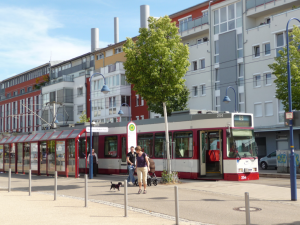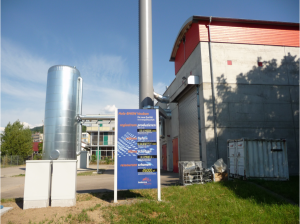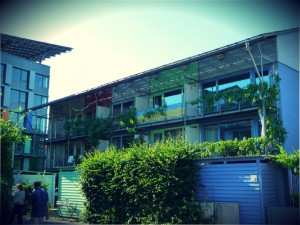Two areas of Freiburg have been developed as eco-villages — Rieselfeld and Vauban. The eco-villages showcase integrated planning based on principles of sustainability.
Rieselfeld, the larger of the two, was built on land that was formerly used for sewage disposal. It lies toward the western outskirts of Freiburg. There are about 4,500 apartments in buildings of 3 to 5 stories housing around about 10,000 people. Most of the buildings are built to a “low energy” standard for heating requirements, which we are told is about 65 kwh/square meter (in Europe they use kilowatt-hours as a basic energy metric in the way we use BTUs).
Solar panels and green roofs appear throughout the development. The ecumenical Maria Magdelena Church has a solar PV system on its roof. The revenue from the feed-in tariffs and electricity savings is used to support solar energy projects in Ethiopia.
Virtually all the buildings in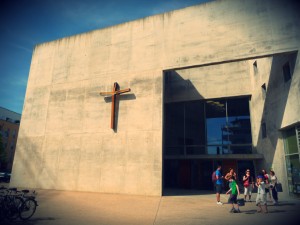 Reiselfeld are connected to the district heating plant located in the development. The plant runs a co-generation system to produce electricity and heat and is fueled by wood pellets produced from a forest certified by the Forest Stewardship Council.
Reiselfeld are connected to the district heating plant located in the development. The plant runs a co-generation system to produce electricity and heat and is fueled by wood pellets produced from a forest certified by the Forest Stewardship Council.
Rieselfeld is adjacent to large areas of open space. Also, open greenspaces have been incorporated in between buildings and arranged in a way to encourage interaction among residents.
In terms of car dependency, Rieselfeld appears to be typical of Germany, although that means there are still a lot of bicycles and walkers. There are bicycle paths and bicycle friendly streets throughout. A tram line comes into the development, making it easy to access the city center.
In contrast, Vauban is a little more “alternative” in feeling. The buildings are set closer together and vegetation around and on the buildings seem more unkempt. We also noticed a lot of children in the development. The eco-village has about 5,500 residents.
Vauban is built on a former French military base. When the Berlin Wall fell and it was clear the French would be leaving, citizens started thinking about the future of the area. The citizens advocated for an affordable residential area. We were told that citizens were much more involved in the planning of Vauban than in Rieselfeld. Freiburg’s 1986 climate protection plan influenced the eco-friendly design. 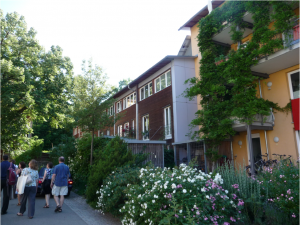
The plan for Vauban retained many of the large trees that were on the former military base and reused some of the buildings.
There are examples of buildings that meet Passivhaus standards (15 kwh/square meter). Passivhaus is a private energy efficiency standard developed in Germany and used by some developers and followed by some cities. The first multi-family building to meet Passivhaus standards in Germany is located in Vauban.
Geo-exchange heat pumps are commonly used. All the buildings are connected to a neighborhood district heating plant, except the multi-family building that was the first to meet Passivhaus standards. That building was intended to be connected to its own biogas plant that was to be fed by sewage from the building. However, the biogas plant was not feasible.
In Vauban, cars are less encouraged than in Rieselfeld. No car parking is included at or adjacent to residences, except for visitor spaces. Residents who own cars are obligated to purchase spaces in one of the common garages (we saw two). The garages have large solar PV arrays. A city tram line goes through the middle of Vauban.
Waste management practices are less conspicuous. Recyclable and compostable materials are collected separately from trash. We were told that there is a system whereby residents can pay lower rates for trash disposal for recycling and composting more and using worm farms. Trash is commonly incinerated in Germany.
Across the street from Vauban is a small Plus Energy housing development, called the Freiburg Solar Settlement. Architect Rolf Disch designed multifamily homes and small commercial buildings to produce more energy than they consume. It’s the first and only such development in Germany, we were told. The buildings are modular units that are mostly pre-fabricated and are finished on site with siding and details. The roofs are completely covered with solar PV panels, which also form long eaves to provide shading in summer and allow sunlight to reach the south side windows in winter.
Rieselfeld and Vauban seem like large leaps for most Americans. But for communities like Cambridge where multi-family residences are the norm, they seem possible. But a key factor that enabled their development in Freiburg is that the City government has more land and public housing under its control. So it is a lot easier for the projects to be planned and sited than in Cambridge.

